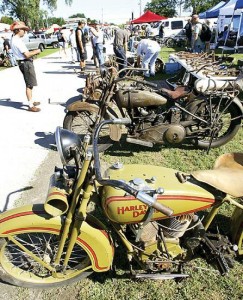Image to the left taken from qctimes.com.
Motorcycles have come a long way since the steam-powered bicycle, or steam velocipede, was patented in the US in 1866. It looked just like a bicycle with an engine, and motorcycles had this basic design for years. By 1868, the velocipede had two cylinders and its own coal-fired boiler. Later, three-wheeled “Moto-Cycles” and steam-powered tricycles made an appearance, and handlebar controls came into use.
The United States was not the only country racing to create motorcycles. In 1885, Gottlieb Daimler and Wilhelm Maybach invented a single-cylinder, gasoline-powered two-wheeled vehicle called the Daimler or the Reitwagen, which is commonly recognized as the first true motorcycle. Daimler’s bike had a wooden chassis and wheels with iron rims and wooden spokes. Several years later, Alex Millet’s motorcycle had pneumatic tires and a five-cylinder engine.
Before 1900, scores of motorcycle designs emerged from Europe and the United States, and most utilized the internal combustion engine. Few were available to the public for purchase at this time. As you might expect, these motorcycles had low compression and not much power, but they were exciting.
One of the earliest motorcycles from bicycle maker Royal Enfield had a 239 cc front-mounted engine that drove power through a belt to the rear wheel. While some early motorcycles were two-stroke, the four-stroke engine known as the Otto Cycle became popular. In 1898, Triumph, also an English bicycle manufacturer, began building motorcycles and the Metz Company of Massachusetts began building the Orient-Aster. A few years later, Harley-Davidson and Indian entered the U.S. market. Indian’s first model was diamond framed with an American-made engine and was painted its trademark red color.
As interest in motorcycle sports grew during this time, so did innovation, and the design of the bike started evolving away from its motorized-bicycle look. By the time World War I started, motorcycle companies were producing thousands of bikes a year, and many were put to good use during the war. After the war ended, BMW came on the scene with motorcycles that were equipped with a shaft drive and a horizontally opposed boxer engine housed with the transmission.
Image to the right taken from motorcycleclassics.com.
Even though the Depression impacted motorcycle companies, Ariel introduced a 1000 cc bike, and Matchless made great technological strides with their V-4 593cc Silver Hawk. In 1934, the OHV Meteor engine was introduced, which was capable of 90 mph. Two years later, the V-twin 998 cc engine achieved speeds of over 100 mph. A new land speed record of 136 mph was set on a modified 1000 cc OHV Harley.
In the 1940s, Honda was founded, and Harley-Davidson replaced their knucklehead engine with the panhead engine and introduced the Hydra-Glide and its new front end. Vincent’s Black Shadow and Black Lightning reached speeds of over 125 mph. During the 1950s, Harley’s FL received a new frame and swinging arm plus a new name—Duo-Glide. Kawasaki, Suzuki, and Yamaha entered the market, and the British manufacturers declined.
The 250 cc motorcycle came of age in the ‘60s with Ducati’s Mach 1, the fastest in its class. Suzuki contributed a two-stroke twin T series engine, and after 1966, their engines were auto oil injection. Harley’s Duo-Glide received an electric start and changed its name to Electra-Glide. Norton’s bikes used a new rubber mounting system to reduce vibration, and Kawasaki introduced a three-cylinder, two-stroke machine. Yamaha’s latest bike had an SOHC parallel twin cylinder engine.
During the 1970s, manufacturers upgraded their engines, and Suzuki introduced several three-cylinder models, while Kawasaki added a four-cylinder SOHC engine. Other innovations included desmodramic valves, autolube systems, full fairing, and left-side gear change. In the ‘80s, Harley-Davidson introduced the Softail model, some bikes receive wind protection, and a major technological leap was antilock brakes on the BMW K1 bikes.
The end of the 20th Century and the beginning of the 21st Century saw a rotary engine bike, the Harley Evolution engine, and the first production diesel-powered motorcycle. Motorcycles continue to evolve technologically and aesthetically. As Goose Creek vehicle accident attorneys, we’re fascinated by changes in motorcycle technology.
If you had to choose the most significant advance in bikes, what would it be, and why?


